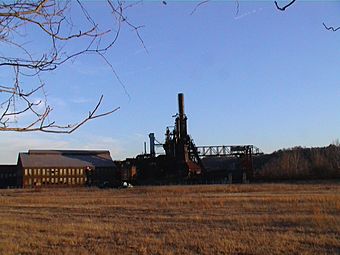Carrie Furnace facts for kids
|
Carrie Blast Furnace Number 6 and 7
|
|

Carrie Furnace
|
|
| Location | Northern side of the Monongahela River 0.5 miles west of the Rankin Bridge in Munhall, Rankin, and Swissvale |
|---|---|
| Area | 168 acres (68 ha) |
| Built | 1884 |
| NRHP reference No. | 06001070 |
Quick facts for kids Significant dates |
|
| Added to NRHP | September 20, 2006 |
| Designated NHLD | September 20, 2006 |
The Carrie Furnace is an old blast furnace located near the Monongahela River in Swissvale, Pennsylvania. It was once a big part of the Homestead Steel Works. The Carrie Furnaces were built in 1884. They made iron until 1982.
At its busiest, this place made over 1,000 tons of iron every day! Today, only furnaces #6 and #7 are left. These two furnaces worked from 1907 to 1978. There is also a special hot metal bridge here. In 2006, the furnaces became a National Historic Landmark. They are some of the only old blast furnaces from before World War II that still exist.
Today, the nonprofit Rivers of Steel Heritage Corporation takes care of the site. They offer tours and special programs from May to October.
Contents
The Story of Carrie Furnace
The Carrie Furnace site is located along the Monongahela River. It covers about 168 acres of land. Most of it is on the north side of the river. The site is surrounded by railroad tracks. Nearby towns include Braddock, Rankin, Swissvale, Whitaker, and Munhall.
Here is a quick look at the history of Carrie Furnace:
- 1881 – Carrie Furnace was built.
- 1892 – The Homestead Strike happened nearby.
- 1898 – Andrew Carnegie bought the site.
- 1901 – It became part of U.S. Steel.
- 1978 – The furnaces stopped working.
- 1988 – The site was sold to Park Corporation.
- 2005 – Allegheny County bought the land for $5.75 million.
- 2006 – Furnaces 6 and 7 were named a National Historic Landmark.
Cleaning Up the Site
After the furnaces closed, there was a lot of cleanup to do. In 1988, when Park Corporation bought the site from U.S. Steel, they agreed to clean it up. Old fuel tanks were removed in 1994. Harmful materials like asbestos were also taken out of the buildings. The soil needed cleaning too.
Experts have studied the site to make sure it is safe. The first study was finished in 2007. More work is still being done to clean up the area.
What's Next for Carrie Furnace?
Many groups are working together to plan the future of Carrie Furnace. These include Allegheny County and the Steel Industry Heritage Corporation. They want to save the old industrial buildings. They also want to use the site for new businesses and homes.
The plan includes building houses, offices, a hotel, and a conference center. There will also be a transportation center and a museum. The old hot metal rail bridge that connected Carrie Furnace to Homestead Works will be changed. It will become a bridge for cars. This new bridge will connect the site to The Waterfront. The Waterfront is a shopping area across the Monongahela River.
The Rivers of Steel Heritage Corp. is also working on a museum. This museum will tell the story of steel. It will be built around the two blast furnaces that are still standing.
Images for kids






